Time-resolved spectroscopy of collinear femtosecond and nanosecond dual-pulse laser-induced Cu plasmas
Qiuyun WANG (王秋云), Hongxia QI (齐洪霞), Xiangyu ZENG (曾祥榆),Anmin CHEN (陈安民),∗, Xun GAO (高勋)and Mingxing JIN (金明星)
1 Institute of Atomic and Molecular Physics, Jilin University, Changchun 130012, People’s Republic of China
2 School of Science, Changchun University of Science and Technology, Changchun 130022, People’s Republic of China
Abstract In this paper, we investigate the time-resolved spectroscopy of collinear femtosecond (fs) and nanosecond (ns) dual-pulse (DP) laser-induced plasmas.A copper target was used as an experimental sample,and the fs laser was considered as the time zero reference point.The interpulse delay between fs and ns laser beams was 3 μs.First,we compared the time-resolved peak intensities of Cu (I) lines from Cu plasmas induced by fs + ns and ns + fs DP lasers with collinear configuration.The results showed that compared with the ns + fs DP, the fs + ns DP laser-induced Cu plasmas had stronger peak intensities and longer lifetimes.Second, we calculated time-resolved plasma temperatures using the Boltzmann plot with three spectral lines at Cu (I) 510.55, 515.32 and 521.82 nm.In addition, time-resolved electron densities were calculated based on Stark broadening with Cu(I)line at 521.82 nm.It was found that compared with ns + fs DP, the plasma temperatures and electron densities of the Cu plasmas induced by fs + ns DP laser were higher.Finally, we observed images of ablation craters under the two experimental conditions and found that the fs + ns DP laser-produced stronger ablation, which corresponded to stronger plasma emission.
Keywords:laser-induced breakdown spectroscopy,fs+ns and ns+fs dual-pulse,time-resolved spectroscopy, plasma temperature, electron density
1.Introduction
Laser-induced breakdown spectroscopy (LIBS) is an element analysis technology that analyzes the composition and content of the sample by detecting the wavelength and intensity of the atomic or ionic spectrum from laser-induced plasma [1–7].LIBS technology has a broad application prospect in the field of element analysis.Compared with traditional detection methods,LIBS has the characteristics of detecting or analyzing the sample with any physical state,extremely weak damage to the sample, no pretreatment to the sample, simultaneous analysis of multiple elements, contactless remote detection ability and high-sensitivity analysis [8–12].Although LIBS technology has unique advantages and good development prospects,with further study of the technology,some bottleneck problems have gradually appeared, which hinder the development of LIBS technology.Consequently, researchers have proposed many methods to improve the spectral intensity.Among these methods, the representative methods are spark-discharged LIBS [13–15], spatially confined LIBS [16–22], the introduction of inert gas [23], pre-heated LIBS [24–26] and magneticfield-confined LIBS [27, 28].
In recent years, dual-pulse (DP) LIBS technology has attracted more and more research interest.DP-LIBS technology uses two beams of laser pulses with an inter-pulse delay to excite the sample.The first laser beam is generally used to pre-ablate the sample, and the second re-excites the sample or the plasma induced by the first laser beam.Compared with single-pulse (SP) technology, the ablation efficiency,spectral line intensity and detection sensitivity of DPLIBS technology have been significantly improved [29, 30].In DP-LIBS,the commonly used DP structures are orthogonal and collinear.Collinear DP structure is also called coaxial DP; two laser beams incident on the surface of the sample in parallel that twice successively irradiate at the same position of the sample.There are two kinds of operation modes in orthogonal DP structure.One is when the first laser beam is perpendicular to the sample surface and generates the plasma.The second laser beam is parallel to the sample surface so that it irradiates vertically on the expanding plasma.The other is when the first laser beam is parallel to the sample surface and breaks down air above the sample surface.Soon afterwards,the second laser beam is perpendicular to the sample surface and generates the plasma.
Numerous researchers have studied the influence of orthogonal femtosecond (fs) and nanosecond (ns) DP-LIBS on spectral intensity and detection sensitivity.Lu et al studied orthogonal fs-ns DP-LIBS for high spatial resolution chemical analysis [31], and found that compared with fs SP-LIBS,fs-ns DP-LIBS enhanced the emission intensity of silicon by about 360 times.Santagata et al studied fs-ns DP laserinduced plasmas with orthogonal DP structure of plasma reheating for copper-based-alloy analysis [32].Their results suggest that the orthogonal fs-ns DP effectively enhanced the signal intensity.Santagata et al also investigated the emission spectra of ultrashort laser reheating titanium plasma[33],and found that the ns laser reheating mechanism was the main reason for signal enhancement.Oba et al used fs and ns lasers to ablate gadolinium oxide [34].Their results indicate that spectral emission could hardly be observed in fs SP-LIBS,while strong spectral emission could be observed in fs-ns DPLIBS.All the above examples used the orthogonal fs-ns DP configuration to improve the spectral signal intensity.However,collinear fs-ns DP configuration is easier to operate than orthogonal configuration and more suitable for remote sensing and long-distance analysis, so the feasibility of the experiment with collinear configuration is better.Therefore,collinear fs-ns DP configuration is used to discuss the spectral emission of DP-LIBS.
During the generation, expansion and disappearance of laser-induced plasma, the particles in the laser plasma undergo excitation, ionization and recombination.During plasma expansion, the distribution of electrons, ions and atoms in the plasma also changes with delay time.By analyzing the characteristics of temporal variation of the plasma,the decay processes of spectral emission intensity, plasma temperature and electron density can be obtained [35, 36].Therefore,time-resolved spectroscopy can intuitively observe dynamic physical processes of laser-induced plasma [37].To date, study of the comparison of fs + ns and ns + fs time-resolved spectra is lacking.Therefore, we investigated the time-resolved spectral characteristics of fs-ns DP-LIBS with different orders.
Due to different ablation mechanisms of fs and ns laser pulses, the order of two sub-pulses in collinear DP configuration will have a specific effect on the spectral intensity,plasma temperature and electron density of the laser-induced plasma.Therefore, we compared the time-resolved emission intensities of Cu plasma induced by collinear fs + ns and ns + fs DP lasers.The inter-pulse delay of fs + ns and ns + fs DP was 3 μs.In addition, the Boltzmann plot was used to calculate the time-resolved plasma temperatures with three spectral lines at Cu (I) 510.55, 515.32 and 521.82 nm,and the time-resolved electron densities were calculated based on Stark broadening with the Cu (I) 521.82 nm line.Finally,the images of the laser ablation crater were observed using a microscope.
2.Experimental setup
A schematic diagram of the experimental setup of fs and ns DP-LIBS is shown in figure 1(a).The experimental system consisted of two laser systems (fs laser and ns laser), a spectrometer equipped with an intensified charge-coupled device (ICCD), a digital delay generator—DG535(StanfordTMResearch System) and a data acquisition computer.The first laser was an ultrafast Ti:sapphire amplifier(coherent Libra) with an 800 nm wavelength and 50 fs pulse width.The second laser was a Q-switched Nd:YAG laser with a 1064 nm wavelength and 10 ns pulse width.The laser beam was vertically focused on a copper sample surface through a mirror, a dichroic mirror, and a focusing lens (BK7) with a focal length of 10 cm.In order to avoid over-ablation, the sample was attached to an x-y-z 3D translation stage so that each DP irradiated on a new sample surface and obtained stable Cu plasma during the experiment.A lens(BK7)with a 75 mm focal length and 50 mm diameter collected the optical signal of the copper plasma and guided it to a spectrometer(Spectra–Pro–500, PI–Acton, the grating is 1200 lines per mm) equipped with an ICCD detector (PI–MAX–4, Princeton–instruments,1024 × 1024 pixels).In the experiment,the two laser systems and the ICCD detector were synchronized by the DG535, and the time-resolved spectroscopy of Cu plasma could be measured.The whole measurement was performed in air with 22 °C room temperature and 40%relative humidity.The timing diagram is presented in figure 1(b).The figure displays the timing relationship between fs, ns, DG535 and ICCD.The signal of the fs laser pulse was considered as the time zero reference point, the inter-pulse delays between fs and ns lasers were 3 μs(ns laser following fs laser, that is fs + ns) and –3 μs (fs laser following ns laser, that is ns + fs).The spectral data were obtained by accumulating 50 DP laser shots.
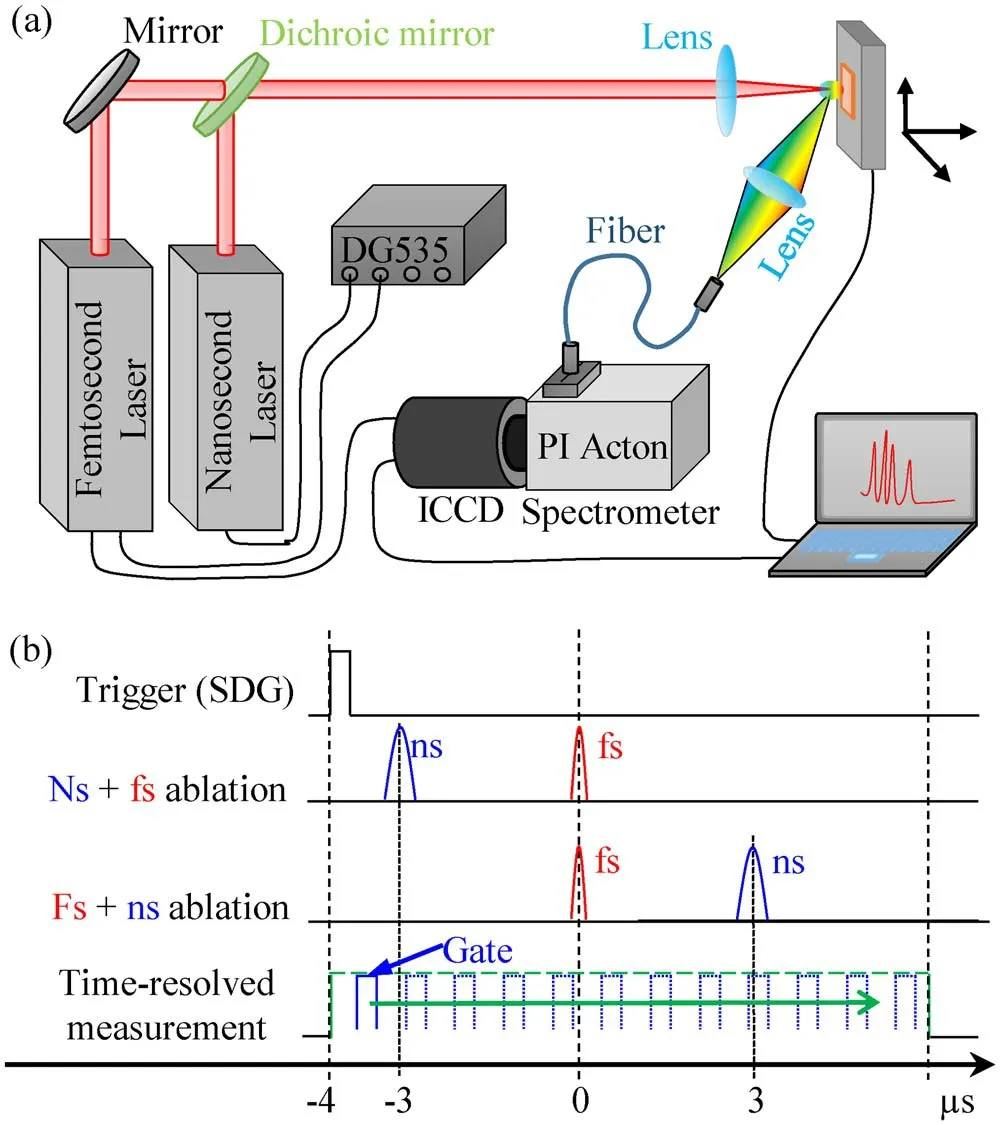
Figure 1.Experimental setup(a)and timing diagram(b)of fs and ns DP-LIBS.
3.Results and discussion
3.1.SP-IBS
We selected three Cu (I) lines at 510.55 nm (the transition of energy level 3d104p1(2P3/2) →3d94s2(2D5/2)),515.32 nm(the transition of energy level 3d104d1(2D3/2) →3d104p1(2P1/2))and 521.82 nm(the transition of energy level 3d104d1(2D3/2)→3d104p1(2P3/2))to study the infulence of collinear fs and ns DP on the optical emission.Compared with other spectral lines,these three lines have the characteristics of high intensity and clear peak.Figure 2 shows time-resolved peak intensities of Cu(I) lines at 510.55 nm and 521.82 nm for fs and ns SP laserinduced Cu plasmas.It is found that ns SP laser-induced Cu plasma has a longer lifetime compared with fs SP laser.Because of the long pulse width of the ns laser, the leading edge and trailing edge of the pulse have different functions.That is to say,the leading edge of the pulse ablates the sample and produces the plasma, and the trailing edge is used as the interaction with the plasma.Therefore,the plasma has a long lifetime.However,fs pulse duration is shorter than the relaxation time between the electron and the lattice [38, 39].Due to the lack of interaction between laser and plasma,there is no effect of plasma reheating,so the duration of the plasma induced by fs laser is shorter.In addition, in earlier delay times from 0–1 μs, the time-resolved peak emission intensity with fs pulse is stronger than that with ns pulse.Freeman et al compared optical emission from ns and fs laser-produced plasmas [38], and their results showed that the atomic line emission with fs laser was stronger than that with ns laser at earlier delay times.Based on the above discussion, we know that fs and ns lasers in SP-LIBS will affect the spectral intensity and lifetime of the plasma.What about DP-LIBS? To this end, we conducted the following discussion.
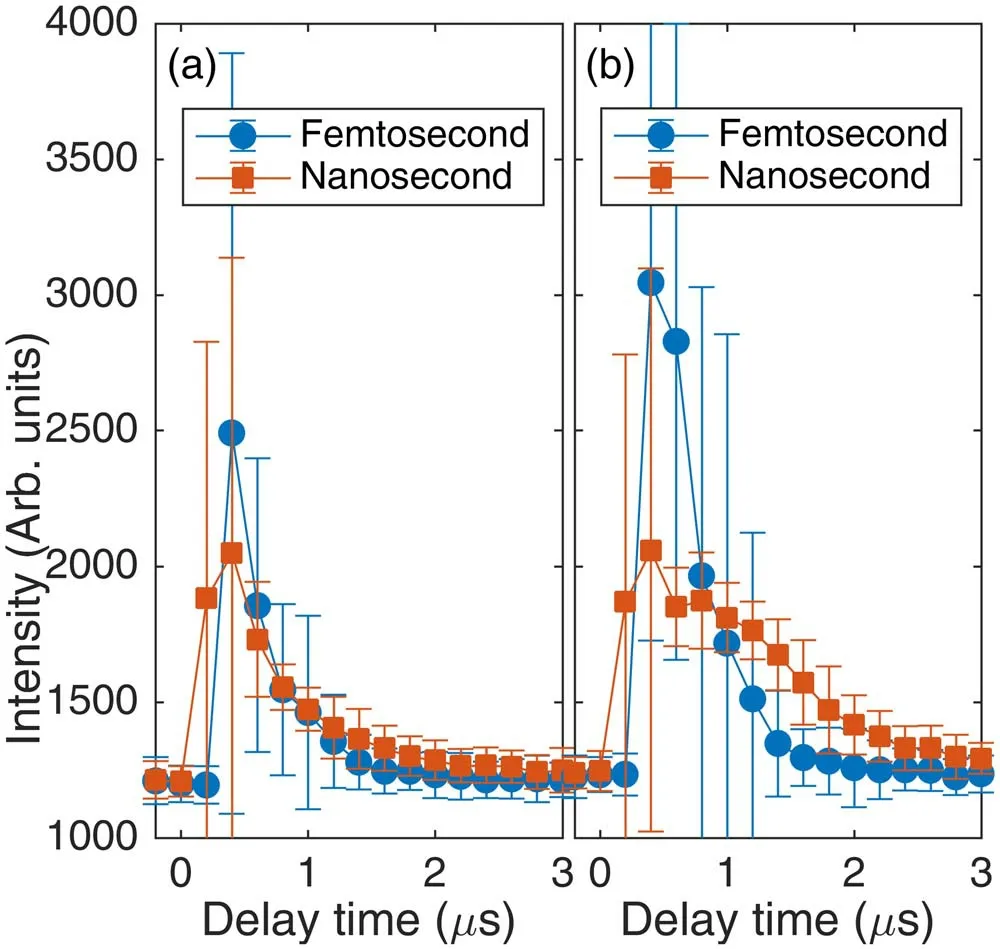
Figure 2.Time-resolved peak intensities of Cu(I)lines at 510.55 nm(a) and 521.82 nm (b) for fs and ns SP laser-induced Cu plasmas.
3.2.DP-LIBS
In DP-LIBS, the inter-pulse delay is very important to the spectral signal.Using appropriate inter-pulse delays can ensure that the second laser pulse can better couple with the plasma produced by the first laser pulse and effectively increase the energy absorption for the second laser pulse,thus increasing the spectral intensity[39].To better understand the emission enhancement of fs and ns DP-LIBS, we measured the time-resolved spectroscopy of laser-induced Cu plasma.Figure 3 displays the evolution of fs + ns DP and ns + fs DP laser-produced Cu plasma spectra with delay times in the wavelength range from 505–525 nm.The delay times from 0–3 μs and 3–6 μs represent fs SP and fs + ns DP,as can be seen from figure 3(a); the delay times from −3–0 μs and 0–3 μs represent ns SP and ns + fs DP, as can be seen from figure 3(b).The energies of fs and ns lasers are 2 mJ.The inter-pulse delays of fs + ns and ns + fs DP lasers are 3 μs.It can be seen from the figure that compared with SP laser,DP laser-induced plasmas have stronger spectral emission and longer lifetime, indicating that using collinear DP can effectively improve the spectral intensity and lifetime of the plasmas.This is because the first laser beam changes the properties of the sample surface, which is conducive to the energy coupling between the second laser beam and the sample, thus increasing the ablation efficiency of the sample and generating stronger laser plasma.In addition, by reheating the plasma produced by the first laser, the collision between particles in the plasma is stronger, making the spectral intensity stronger and lifetime longer.It can also be observed from the figure that the combination of fs + ns DP has stronger spectral emission and longer lifetime compared with that of ns + fs DP.In order to observe this phenomenon more clearly, we presented the time-resolved spectral peak intensities.

Figure 3.Evolution of fs + ns DP (a) and ns + fs DP (b) laserinduced optical emission with delay time.Gate width is 0.2 μs.
To describe the changes in peak intensities with delay time more clearly, we plotted figure 4 according to figure 3.Figure 4 shows time-resolved peak intensities of fs + ns DP and ns + fs DP laser-induced spectral lines at 510.55 and 521.82 nm.In addition, we fitted exponential decays of fs + ns DP and ns + fs DP in figure 4.The exponential decays at 510.55 and 521.82 nm for fs + ns lasers are 0.84 ± 0.02 ns and 1.21 ± 0.07 ns.The exponential decays at 510.55 and 521.82 nm for ns + fs lasers are 0.22 ± 0.04 ns and 1.26 ± 0.01 ns.Compared with ns + fs DP, the combination of fs + ns has stronger spectral peak intensity and longer lifetime.The fs laser has a short pulse width and high peak power compared with the ns laser [40].Based on figure 2, the spectral emission of the fs laser at 0.5 μs is extremely strong.As the delay time increases, the spectral emission rapidly decreases to almost nothing, indicating that the plasma is very weak.As a result, the second pulse (ns laser) will directly irradiate the sample, and the first pulse (fs laser) causes a significant change in the properties of the sample surface (the larger ablation area), resulting in strong coupling between the second pulse (ns laser) and the sample surface.In addition, it is obvious from figures 5 and 6 that compared with ns + fs DP, the plasma generated by fs + ns DP has a higher plasma temperature and electron density,indicating that fs + ns DP has a stronger interaction with the sample surface, resulting in a stronger spectral emission and longer plasma lifetime.

Figure 4.Time-resolved peak intensities of fs + ns DP (a) and ns + fs DP(b)laser-induced spectral lines at 510.55 and 521.82 nm from figure 3.
However,ns laser has a long pulse duration and low peak power compared with fs laser [41].Based on figure 2, the spectral intensity with ns laser at 0.5 μs is weaker than that with fs laser.With the increase in delay time, the spectral emission with ns laser is always stronger than that with fs laser,and the lifetime with ns laser is longer than that with fs laser, which indicates that the plasma has longer persistence.The plasma will prevent the second beam (fs laser) from irradiating the sample surface (plasma-shielding effect) [41],and the energy of the fs laser reaching the sample surface is weakened.In addition, the first pulse (ns laser) has a weak change in the properties of the sample surface (smaller ablation region), resulting in a weak coupling between the second pulse (fs laser) and the sample surface.It is evident from figures 5 and 6 that compared with fs + ns DP, the plasma generated by ns + fs DP has a lower electron temperature and electron density, which indicates that ns + fs DP has a weaker interaction with the sample surface, resulting in a weaker spectral emission and shorter plasma lifetime.
It is very important to investigate the plasma temperature and electron density of DP-LIBS to understand the emission enhancement mechanisms of fs and ns DP laser-induced plasmas.Assuming that the plasma is in local thermal equilibrium (LTE), the electron temperature of the plasma is calculated by the Boltzmann plot method as follows[42–44]:

where i and k are the higher and lower levels; Iikis the intensity; kBis the Boltzmann constant; gkis the statistical weight at the higher level; Aikis the relative transition probability; Ekis the energy at the higher level; λikis the wavelength; C is the constant; T is the electron temperature[45–47].All the spectral parameters gk,Aikand Ekcome from the atomic spectra database (National Institute of Standards and Technology).The electron temperature of the plasma is calculated using the three lines at Cu (I) 510.55, 515.32 and 521.82 nm.Figure 5 shows the time-resolved electron temperatures of fs + ns DP and ns + fs DP laser-induced Cu plasmas.It is found that compared with the ns + fs combination, the combination of fs + ns has higher electron temperatures, which is consistent with the changes in the peak intensities of the plasma with the delay time, as shown in figure 4.The fs laser causes a significant change in the properties of the sample surface(larger ablation region),resulting in strong coupling between the second pulse (ns laser) and the sample surface,so the plasma temperature is higher.However,the ns laser causes a slight change in the properties of the sample surface (smaller ablation region), resulting in a weak coupling between the second pulse (fs laser) and the sample surface, so the plasma temperature is lower.
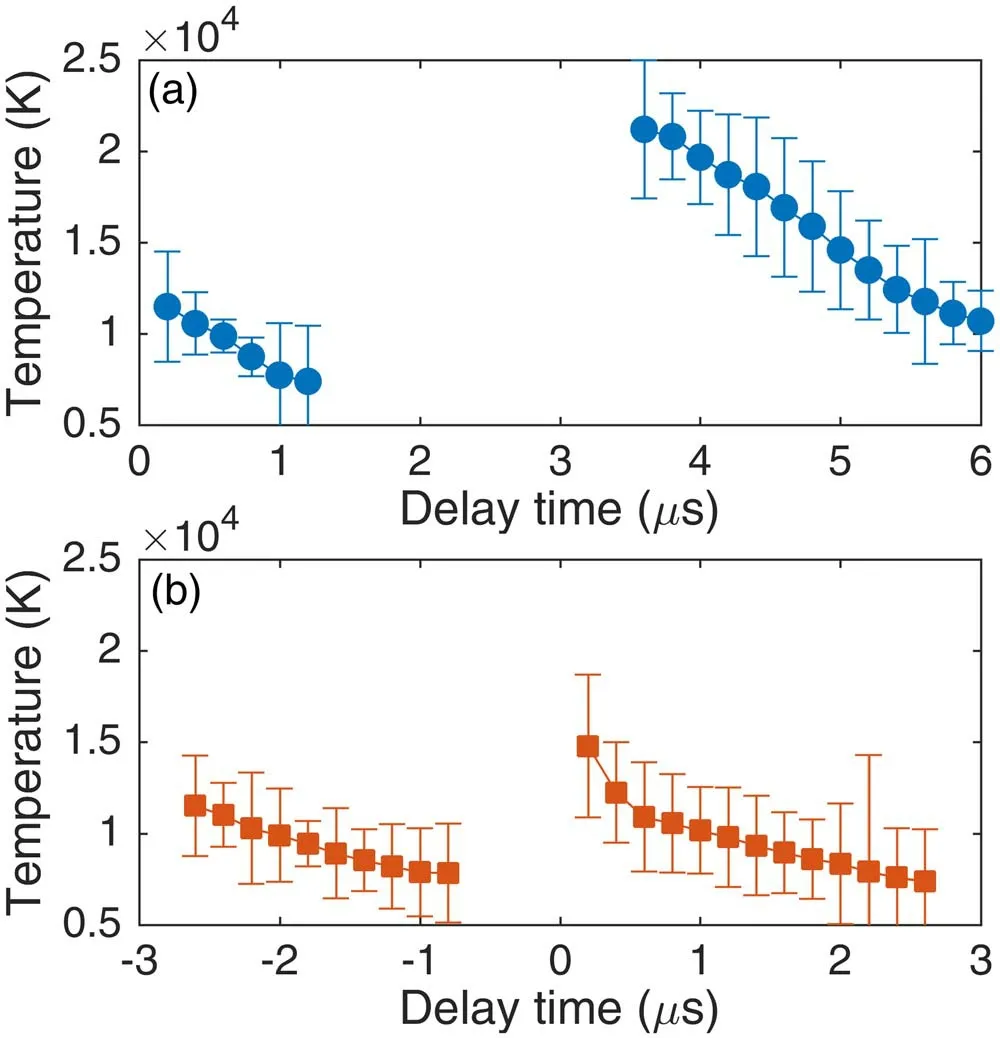
Figure 5.Time-resolved plasma temperatures of fs + ns DP(a) and ns + fs (b) DP laser-induced Cu plasmas.
Many factors cause the broadening of the atomic spectral line, including natural broadening, Doppler broadening,instrument broadening, Holtzmark broadening and Stark broadening.In the plasma, natural broadening, Doppler broadening and Holtzmark broadening can be ignored.The relationship between the full width at half maximum(FWHM)of the line caused by Stark broadening(Δλ1/2)and electron density is as follows [48–50]:

where ω is the impact parameter [51], and neis the electron density.The width(Δλmeas)of Cu(I)521.82 nm is obtained by using Lorentz fitting.The instrument broadening (Δλinstr) is approximately 0.04 nm obtained by measuring the spectral line of the low-pressure mercury lamp.Both Doppler broadening and natural broadening can be ignored, Δλmeas= 0.5346Δλ1/2+[52, 53].Figure 6 shows the time-resolved electron densities of fs + ns DP and ns + fs DP laser-induced Cu plasmas.It is found that the time-resolved electron density decreases with the increase in the delay time.With the increase in delay time, the plasma expands rapidly,increasing the plasma volume.It is also found that compared with the ns + fs combination, the combination of fs + ns has higher electron densities,which is consistent with the changes in the peak intensities and the electron temperatures with the delay time, as shown in figures 4 and 5.This indicates that the interaction between fs + ns DP and the sample is stronger than that between ns + fs DP and the sample.The fs + ns DP can produce higher temperature and higher-density plasmas compared with the ns + fs DP,resulting in stronger plasma spectra.

Figure 6.Time-resolved electron densities of fs + ns DP (a) and ns + fs (b) DP laser-induced Cu plasmas.
A microscope was used to observe the image of the crater on the surface of the sample ablated by fs SP,ns SP,fs + ns DP,and ns + fs DP lasers.Figure 7 presents the image of the ablation crater with fs SP,ns SP,fs + ns DP,and ns + fs DP lasers.Figures 7(a) and (b) show that the ablation area in the middle of fs SP is significantly stronger than that of ns SP.The spatial energy distribution of fs and ns lasers is Gaussian beam, so the energy in the central region is high, and the power in the surrounding area is low.Consequently,when ns laser irradiates the sample, the central part reaches the ablation threshold,but the surrounding region does not match the ablation threshold, resulting in a smaller ablation area.However,the pulse width of the fs laser is extremely narrow,and the peak power is extremely high, so the ablation area is relatively large [40, 41].Figures 7(c) and (d) show that the ablation area in the middle of fs + ns DP is significantly stronger than that of ns + fs DP.The ablation region in the middle of fs + ns DP is large, indicating that the sample can absorb more laser energy.However,the ablation with ns + fs DP is weaker than that with fs + ns DP, indicating that ns + fs DP does not provide enough double-pulse advantage.The changes in peak intensity,electron temperatures,electron densities and the ablation crater suggest that fs + ns DP is more suitable for laser ablation and plasma emission compared to ns + fs DP.
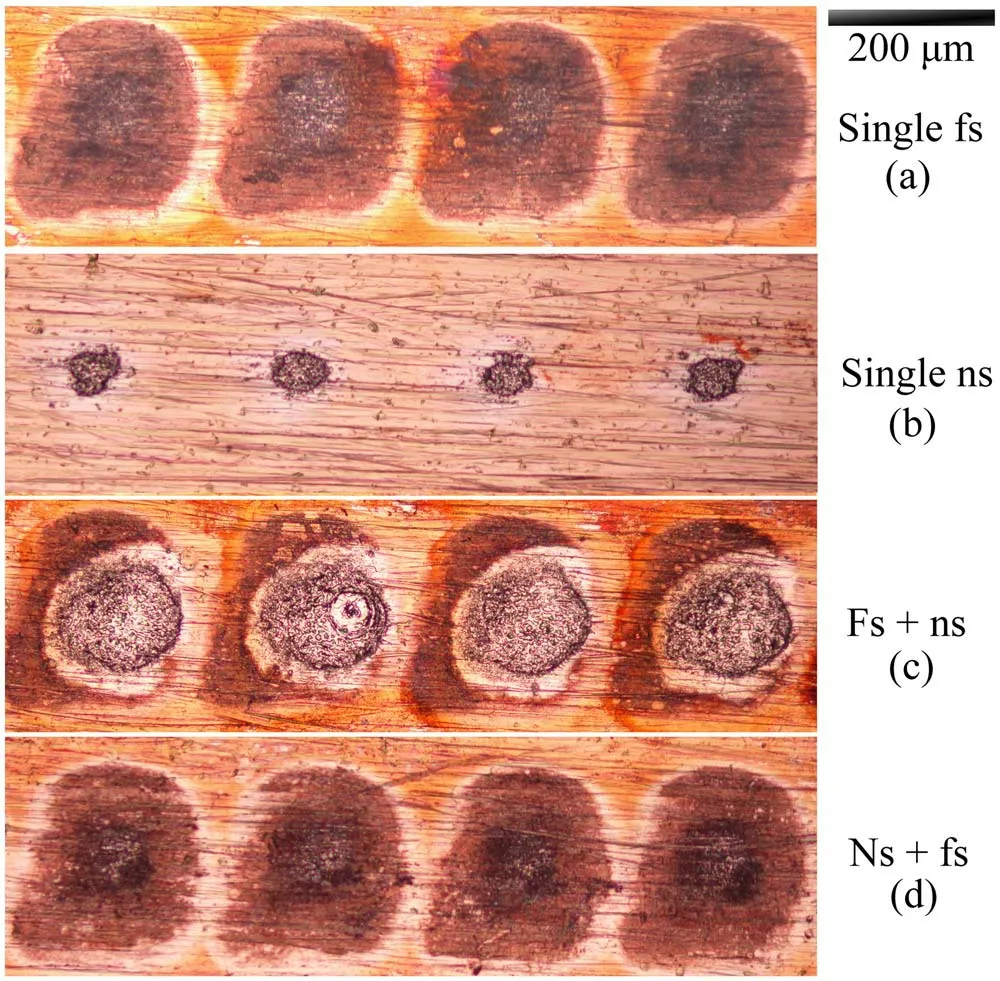
Figure 7.Images of fs SP(a),ns SP(b),fs + ns DP(c)and ns + fs DP (d) laser ablation craters.
4.Conclusion
In this paper, we mainly discussed the spectral enhancement effect of fs and ns DP-LIBS on Cu plasmas.First, we measured the time-resolved spectra of fs + ns and ns + fs DP lasers, and found that compared with ns + fs DP laser,fs + ns DP laser produced stronger plasma, resulting in stronger plasma emission and longer lifetime.Second, we obtained the time-resolved plasma temperature and electron density using the Boltzmann plot and Stark broadening, and found that the time-resolved plasma temperature and electron density excited by fs + ns DP were higher than that excited by ns + fs DP.Finally, through a microscope we observed images of ablation craters under two experimental conditions,and found that fs + ns DP generated stronger ablation,which corresponded to stronger plasma emission.Analysis of spectral intensity, plasma temperature and electron density suggested that fs + ns DP laser is more suitable for laser ablation and plasma generation compared with ns + fs DP.We hope that this study will provide a helpful reference for the further development of DP-LIBS.
Acknowledgments
We acknowledge the support of National Natural Science Foundation of China (Nos.11674128, 11674124 and 11974138) and the Scientific and Technological Research Project of the Education Department of Jilin Province, China(No.JJKH20200937KJ).
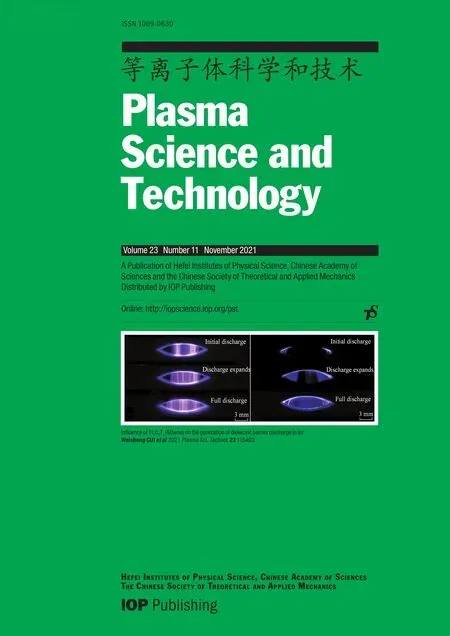 Plasma Science and Technology2021年11期
Plasma Science and Technology2021年11期
- Plasma Science and Technology的其它文章
- Influence of magnetic filter field on the radiofrequency negative hydrogen ion source of neutral beam injector for China Fusion Engineering Test Reactor
- Investigation on current loss of high-power vacuum transmission lines with coaxial-disk transitions by particle-in-cell simulations
- A low-jitter self-triggered spark-discharge pre-ionization switch: primary research on its breakdown characteristics and working mechanisms
- A calculation model for breakdown time delay and jitter of gas switches under hundred-nanosecond pulses and its application in a self-triggered pre-ionized switch
- Study of tetracycline removal and saturated resin regenerated by dielectric barrier discharge plasma
- Experimental study on the parameter optimization and application of a packed-bed dielectric barrier discharge reactor in diesel particulate filter regeneration
